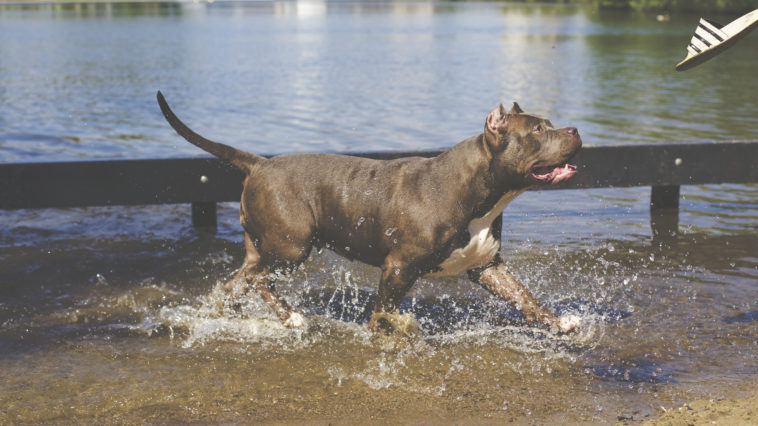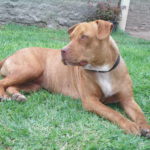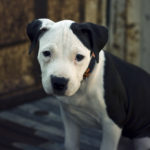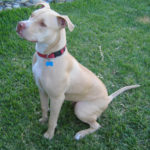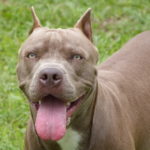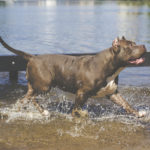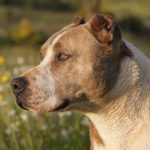
One of the many dog breeds lumped into the “Pit Bull” category, the American Pit Bull Terrier (APBT) is nothing to be afraid of – the breed is perfectly suitable to be a family and companion dog. The “bull” part of the name comes from their breeding origin, as they were meant to bait bulls. However, as time went on, the Pit Bull evolved to be a farm dog and eventually a “nanny” dog, due to their gentle behavior around children. Pit Bulls make great competitors for agility, weight pulling, and obedience competitions due to their courage, tenacity, and gameness.
Did You Know?
- Pit Bulls are naturally strong. However, they are also stubborn and bossy. It’s important to train and socialize them at an early age, otherwise they can become hard to handle if you haven’t taught them who’s in charge.
- Because of their bad reputation, Pit Bulls of all kinds are usually included in breed-specific legislations. If you own one, make sure to check your local ordinances regarding Pit Bulls, as well as other regions if you plan on traveling with your dog.
- A mix of gentle, consistent discipline and firm, fair training are best suited for American Pit Bull Terriers.
- If you have a busy life and will spend little to no time with your dog, then an American Pit Bull Terrier is not for you.
- American Pit Bull Terriers tend not to get along with other dogs, especially if they haven’t been socialized properly from a young age. Don’t let them loose in dog parks and keep them on a leash in public, especially when around other dogs. Pit Bulls never back down from a fight, so don’t let one get started.
- Pit Bulls have powerful jaws, so make sure you get them tough, durable toys. Otherwise, they will chew right through cheap and flimsy toys, possibly swallowing them by accident.
Breed Characteristics
Adaptability

Adapts Well to Apartment Living: 3.5/5
Good for Novice Owners: 1.5/5
Tolerates Being Alone: 1.5/5
All-Around Friendliness

Affectionate with Family: 5/5
Dog-Friendly: 0.5/5
Friendly Toward Strangers: 4.5/5
Health Grooming

Amount of Shedding: 3.5/5
Easy to Groom: 5/5
General Health: 4.5/5
Trainability

Easy to Train: 4/5
Intelligence: 3.5/5
Tendency to Bark or Howl: 3.5/5
Exercise Needs

Energy Level: 4.5/5
Exercise Needs: 4.5/5
Potential for Playfulness: 5/5
Overview
The term “pit bull” is used to cover various related breeds and is not a breed itself. Some of the breeds that fall under the “pit bull” category include the American Pit Bull Terrier, the American Staffordshire Terrier, the Staffordshire Bull Terrier, and the Bull Terrier.
Depending on who you ask, the American Pit Bull Terrier (APBT) is either the same breed or a different breed than the American Staffordshire Terrier. The confusion arose when the American Kennel Club (AKC) decided to give the American Pit Bull Terrier a different name, in order to separate it from its pit-fighting past. The American Staffordshire Terrier is slightly smaller and has been recognized by the AKC, while the slightly bigger American Pit Bull Terrier has not.
Because the breed is known for its obedience, agility, and strength, many unscrupulous people look to use them for illegal dog-fighting competitions even today. Due to this, pit bulls have gained a bad reputation even though they are very gentle and friendly when dealing with humans.
This bad reputation, which the breed has gained through no fault of their own, has even reached the legislative world as a number of cities and countries around the world have passed restrictive ordinances and legislation against the breed.
Prepare to be met with hostility from misinformed people if you plan on adopting a pit bull. Be ready to invest time in training and socialization when it comes to raising your pit bull. They need consistent and firm guidance. As you properly train them, pit bulls will make excellent companions for both adults and children. American Pit Bull Terriers are loving and gentle with their family and are excited to meet strangers.
American Pit Bull Terriers are not brutes. They are extremely intelligent and are able to learn commands and tricks easily. Even as they grow up, pit bulls maintain the same demeanor they had as puppies, which makes them a joy to be around. Pit bulls love to be involved in everything surrounding them and make great companions.

History
Bull-baiting and bear-baiting were popular spectator sports during early 19th century England, and bull and terrier breeds were created specifically to participate in this blood sport. In 1835, these sports were deemed inhuman and illegal. Ironically, an equally inhuman sport – dog-fighting – took its place, which is where the aggression trait was bred into the pit bull’s genetic line.
Even though aggression was bred into the dogs, an unwillingness to hurt and bite humans was also part of the breed’s genetic makeup. This proved important to their handlers, who wanted to be able to reach into the dog-fighting rings and separate the dogs without getting mauled. Due to these characteristics, the breed gained a reputation for being both a gentle and family-friendly dog as well as strong and protective.
Often referred to as “bull dogs,” the pit bull became an all-around farm dog when immigrants brought the breed over to America. The dogs were developed into bigger versions of their English counterparts and were used to provide companionship, hunt wild game, and as a guard dog to protect the property from intruders.
In 1898, the United Kennel Club (UKC) – the American Kennel Club’s British counterpart – gave the breed the name of American Pit Bull Terrier (APBT). The pit bull breed was recognized by the AKC during the early 1930’s. Because it wanted to separate the dog from its pit-fighting past, the AKC decided to recognize the breed under a different name – the American Staffordshire Terrier.
There are very slight differences in build and personality between the American Pit Bull Terrier and the American Staffordshire Terrier due to its breeding. For example, the Staffordshire has been bred for AKC dog shows, while the Pit Bull has not.
Size

Male pit bulls have an average height of 18 to 19 inches while females range from 17 to 18 inches in height. For both of them, a weight range of 30 to 85 pounds is common.
Appearance
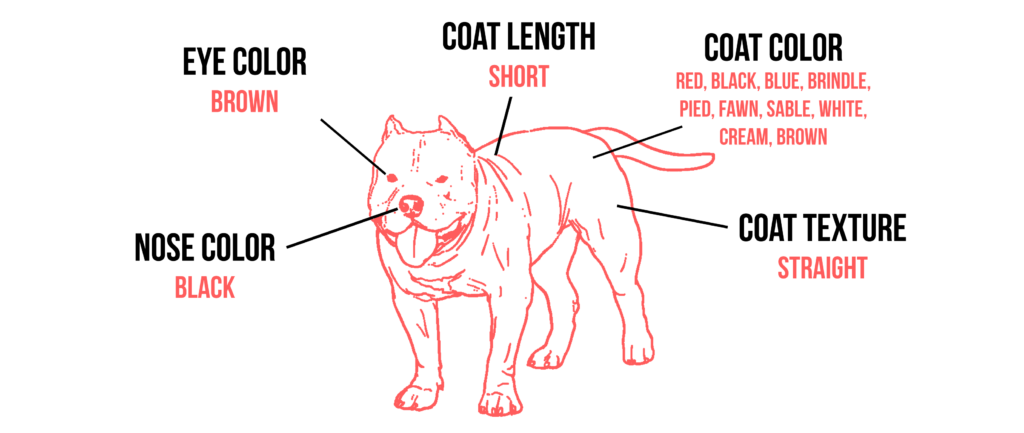
Pit bulls have shiny short coats that are stiff to the touch. Their coat comes in various colors – blue, grey, blue, brown, brindle, and black and white.
Behavior
Personality
Pit bulls are very friendly dogs and will often try to sit on your lap, not knowing their size might make them a little bit too big for it. When they sense the presence of strangers, they alert you immediately, mostly because they are excited about greeting them. Their confidence and keen awareness of their surroundings makes them great watchdogs.
Unfortunately, they are not as great when it comes to being guard dogs. This is because they are genetically predisposed to loving people, whether family or strangers. However, they are courageous and will put their lives on the line to defend their family when in danger.
If you want your pit bull to grow up to be a well-rounded dog, make sure you expose him to many different experiences, sights, sounds, and people from an early age.
Children and Other Pets
Just like they love people, American PitBull Terriers (APBT) also love children. Pit bulls make ideal playmates for kids due to their energetic, sturdy, and tolerant demeanor. However, keep in mind that no dog should be left alone with children and always have someone supervising them.
If neither you nor any other adult can be present to supervise your dog interacting with children, make sure you crate your dog. This is especially important after they become sexually mature, as they will want to test the possibility of becoming a “pack” leader.
It’s also important that you teach your children how to appropriately behave with the dog. Teach them not to bother them in their sleep and to never try to take away the dog’s food. Also teach them to avoid pulling on their dog’s ears and tail.
Socialization is important for any dog, but especially for the American Pit Bull Terrier. Due to their genetic makeup and how they were bred for dog-fighting and bull-baiting, pit bulls are naturally aggressive towards other animals, especially towards other dogs. However, if you train them properly from an early age, pit bulls can overcome that aggression and turn into dog-friendly and cat-friendly pets. However, just like with children, pit bulls should always be supervised when other pets are in the same room.
Health
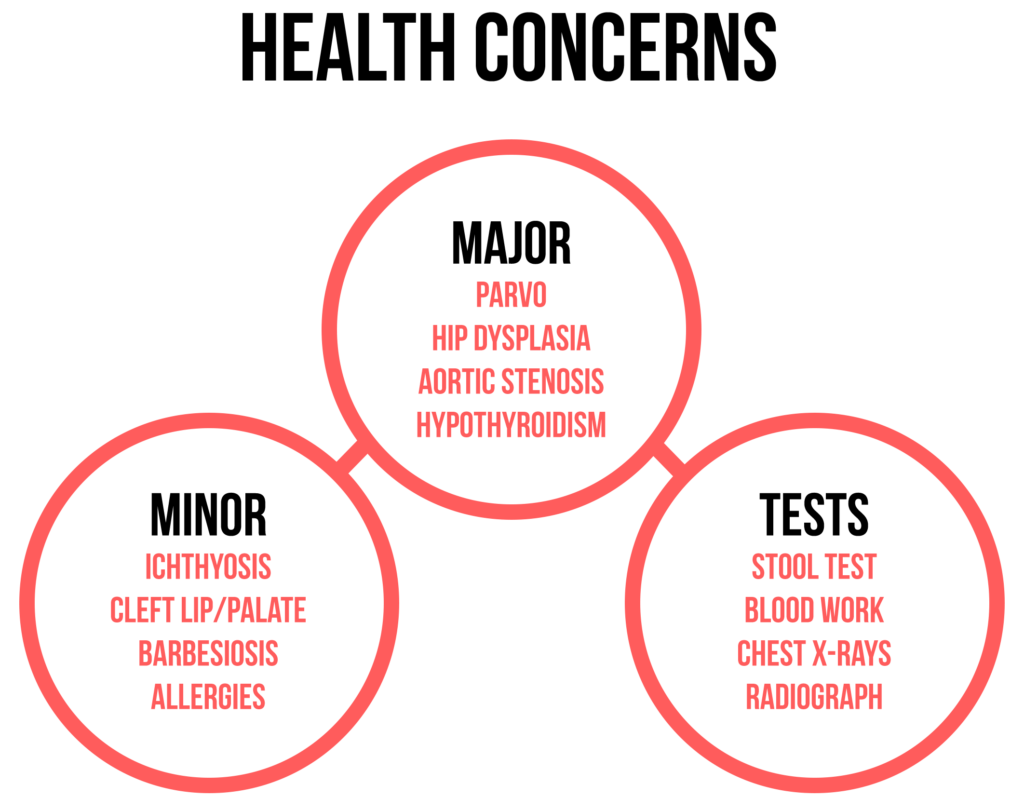
Pit bulls live generally healthy lives. However, there are certain conditions that affect them more than other breeds. Be aware of these conditions so that you know what to do in case your pit bull falls ill to one of them.
Hypothyroidism
When suffering from this condition, your pit bull’s thyroid gland will produce abnormally low levels of hormones. Due to this dysfunction, your pit bull can gain weight, have poor coating, and suffer from reproductive problems among other issues. Your pit bull’s skin can also become dark and tough, while their fur will become coarse and brittle and even fall out.
The condition usually happens in middle-aged dogs. Other symptoms of the condition include mental dullness, drooping eyelids, irregular heat cycles, lethargy, and overall low levels of energy. Luckily, the condition can be treated through medication. The medication must be administered on a daily basis for the rest of your dog’s life and, if properly managed, your pit bull can continue to lead a long and healthy life.
Allergies
Dogs, in general, can suffer from a variety of allergies. American Pit Bull Terriers and American Staffordshire Terriers, however, are more likely to suffer from allergies than other dog breeds. Food allergies are usually not common for them. If they do have food allergies, it will usually be related to beef, rice, corn, and/or wheat. Skin allergies are more common, such as from fleas, grass, pollen, or dust.
Due to the great discomfort and itching allergies can cause, a pit bull will dig and chew incessantly, even if they start bleeding. This may cause secondary infections, which is why it’s important to treat allergies right away. Veterinarians can help you determine what type of allergy your pit bull has and will be able to recommend the appropriate treatment.
Heart Disease
The most common heart disease affecting American PitBull Terriers is aortic stenosis. This condition is congenital (meaning the dog’s born with it), and it’s described as an abnormal narrowing of the connection between the left ventricle and the aorta. There may be little or no signs accompanying the condition. Your dog can also show low levels of energy or they may even die all of a sudden. Take your pit bull to the vet and have your dog tested early on. If the veterinarian hears a heart murmur, it’s best to confirm the diagnosis by running a chest x-ray and an electrocardiogram.
Hip Dysplasia
Hip Dysplasia is a condition passed down from parent to pup where there’s a malformation of the hip joint ball and socket, which can cause extreme pain and lameness on one or both rear legs depending on the severity of the condition. However, keep in mind that the condition can exist without clinical signs, which is why it’s important to screen your dog and have them X-rayed to make sure they don’t suffer from hip dysplasia. Dogs with hip dysplasia can also develop arthritis as they age.
Maintenance

Care
American Pit Bull Terriers are naturally strong and stubborn, which is why it’s important to take them to obedience training as early as possible and to continue the training throughout your pet’s life. Proper training helps build trust between pit bull owner and the dog and will form a strong foundation for your relationship.
If you own or plan on adopting one, prepare to spend about an hour a day playing, exercising with, or just walking your pit bull. They don’t adapt well to cold climates and should be kept as indoor pets. By keeping them as house dogs instead of outside dogs, they will form a strong bond with their families. They also don’t like spending time alone, so don’t plan on leaving it by itself for long periods of time.
Feeding
While every dog should be served an amount of food based on their specific characteristics, the average recommended amount a pit bull should be served daily is between 1.5 to 2.5 cups of high-quality dry food, divided into two meals.
Obesity causes health problems in dogs, just like in humans, so keep your dog feeling healthy by measuring your dog’s food daily instead of leaving it out. If you can’t see his waist or feel his ribs beneath a layer of muscle, then it’s time for your pit bull to go on a diet.
Grooming
American Pit Bull Terriers are easy to groom, as their short coat is easy to clean with the occasional bath. To keep their coat shiny, brush it with a stiff brush and wipe it down with a cloth.
To prevent gum disease and bad breath, brush their teeth daily. This also helps to remove tartar buildup and bacteria. If for some reason you can’t brush their teeth every day, try to do it at least two or three times a week.
Dogs can naturally wear down their nails, but if they don’t, make sure you trim their nails once or twice a month. This helps to prevent painful tears and other problems. A dog’s nails have blood vessels, so be careful when trimming their toenails – if you go too far, you can cause bleeding. If you don’t feel comfortable trimming your dog’s nails, ask a vet for pointers or take them to a professional groomer.
Check your pit bull’s ears at least once a week for redness or bad odor, as those may be signs of infection. To prevent ear infections, wipe their ears out with a cotton ball dampened with gentle, pH-balanced ear cleaner. Make sure you clean the outer ear – don’t go into the ear canal.
Prepare your pit bull puppy for grooming from puppyhood. Look inside their mouth and ears and handle their paws frequently, as dogs tends to be touchy about their feet. By making their grooming experience a positive memory, it will be much easier when you need to visit the vet or when you need to handle him yourself as an adult.
As you groom your pit bull weekly, check for possible health problems such as rashes, sores, or signs of infections like tenderness, redness, or inflammation on the feet, skin, mouth, nose, and eyes. Their eyes should be clear with no discharge or redness. As you examine him on a weekly basis, you can help keep your pet healthy by spotting potential health issues early on.
Questions
How long do American Pit Bull Terriers live?
American Pit Bull Terriers have an average lifespan of 12 to 16 years.
Are pit bulls naturally more aggressive?
Pit bulls get a bad rap due to their bull-baiting past and because some people use them for illegal dog fights. However, pit bulls are naturally very gentle and affectionate towards humans. In fact, that’s one of the reasons why pit bulls were chosen for the horrible and illegal “sport” of dog fighting: owners wanted a dog that would attack its opponent but not their human owners. Pit bulls have had tragic histories, but they are one of the most lovable animals out there and will always try to please their human.
Why isn’t the American Pit Bull Terrier accepted by the AKC?
Because of continuous misunderstandings of the breed, the American Kennel Club wanted to distance itself from the pit bull’s tragic and violent past. Instead of accepting the American Pit Bull Terrier, they renamed it the American Staffordshire Terrier and focused on different breeding standards. The AST is very similar to the APBT but is usually smaller in size.
Resources
Rescue Groups
Just about every shelter in the country has a pit bull of some kind. There are also several great rescue groups focused on finding homes for these sadly misunderstood companions. Check out our list below to find a shelter close to you.
Breed Organizations
Click on any of the links below to find additional information about the American Pit Bull Terrier from these breed clubs, associations, and organizations.
Top Breeders
The following is a list of the most reputable American Pit Bull Terrier breeders of 2017.
- Tom Garner Kennels (Hillsborough, North Carolina)
- Colby Pit Bull Kennels (Sacramento, California)
- Against The Wind Kennels (Three Forks, Montana)
- On The Rise Pitbulls (Jacksonville, Florida)
